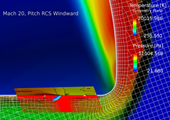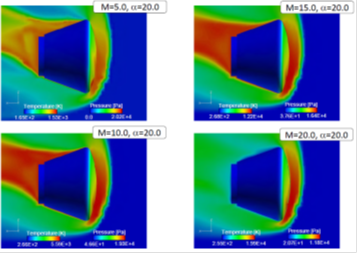Design analysis for technology demonstration project of small capsule installed in HTV
JAXA Supercomputer System Annual Report April 2016-March 2017
Report Number: R16E0121
- Responsible Representative: Jun Gomi(Human Spaceflight Technology Directorate)
- Contact Information: Keiichiro Fujimoto(fujimoto.keiichiro@jaxa.jp)
- Members: Takayuki Ito, Keiichiro Fujimoto, Tetsufumi Ohmaru
- Subject Category: Space(Rocket,Space transportation)
Abstract
Evaluation of the heat flux induced by the RCS jet and free-stream interaction is conducted. For each RCS thrustors, wide range of heat flux CFD analysis is conducted.
Goal
By employing multi-disciplinary coupling analysis based on the high-fidelity numerical simulations, new quantitative safety analysis method is under the development. Objective of this study is that by reducing uncertainty on the safety analysis, further improvement in the safety for the space debris problems with keeping the international competitiveness of the performance.
Objective
For the practical use of the high-fidelity numerical simulations in the safety analysis, analysis turn-around time aimed to be reduced by half. Then, new destructive re-entry safety analysis method will be developed, and it would contribute to realize the ease of the safety limitations.
References and Links
Please refer ‘JEDI Center(JAXA’s Engineering Digital Innovation Center)‘.
Use of the Supercomputer
Perform hundreds of the aerodynamic and heat flux analysis for the wide range of flow conditions.
Necessity of the Supercomputer
Accurate high-fidelity numerical simulations for the complicated physics under the wide range of conditions is essential for the quantitative safety analysis. In addition, the analysis methods and its results are high-level confidential information. Therefore, high-performance own supercomputer system is essential.
Achievements of the Year
Research and development activities to realize next generation space transportation and re-entry systems such as the small re-entry capsule installed in HTV and the re-usable fly-back booster are under the way at JAXA. In the aerodynamic design studies for such vehicles, large-scale parametric CFD analysis under the wide range of flow conditions is essential. Aerodynamic analysis is the most time-consuming process which is the bottle-neck for the conceptual design and the probabilistic analysis. In this study, rapid turn-around time CFD tool (LS-FLOW) is employed for such parametric studies.
For the development of small re-entry capsule installed in HTV, the aerodynamic and heat flux prediction including the RCS jet and main stream interaction are numerically studied. As a preliminary analysis, hypersonic flow over the capsule under the multiple Mach number conditions are numerically investigated as shown in Fig.1. Based on the obtained capsule flow fields, near field flow analysis is also conducted for the evaluation of heat flux induced by the RCS jet and free-stream interactions as shown in Fig.2.

Fig.2:Heat-flux analysis induced by the RCS jet and free-stream interaction for small re-entry capsule installed in HTV.
Publications
Non peer-reviewed articles
1) An analysis of illumination conditions by altitude for a landing site near the Lunar north pole, 48th Lunar and Planetary Science Conference (LPSC XLVIII)
http://www.hou.usra.edu/meetings/lpsc2017/pdf/1377.pdf
Computational Information
- Parallelization Methods: Hybrid Parallelization
- Process Parallelization Methods: MPI
- Thread Parallelization Methods: OpenMP
- Number of Processes: 234
- Number of Threads per Process: 4
- Number of Nodes Used: 30
- Elapsed Time per Case (Hours): 240
- Number of Cases: 78
Resources Used
Total Amount of Virtual Cost(Yen): 426,939
Breakdown List by Resources
| System Name | Amount of Core Time(core x hours) | Virtual Cost(Yen) |
|---|---|---|
| SORA-MA | 0.00 | 0 |
| SORA-PP | 0.00 | 0 |
| SORA-LM | 0.00 | 0 |
| SORA-TPP | 27,306.35 | 402,632 |
| File System Name | Storage assigned(GiB) | Virtual Cost(Yen) |
|---|---|---|
| /home | 55.68 | 449 |
| /data | 2,196.63 | 17,727 |
| /ltmp | 759.55 | 6,129 |
| Archiving System Name | Storage used(TiB) | Virtual Cost(Yen) |
|---|---|---|
| J-SPACE | 0.00 | 0 |
Note: Virtual Cost=amount of cost, using the unit price list of JAXA Facility Utilization program(2016)
JAXA Supercomputer System Annual Report April 2016-March 2017



